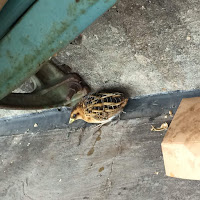 |
| This unusually cooperative king rail treated birders to fine views last year at Montrose Point in Chicago. The bird was spotted multiple times from May to July. Photo by Jim Hully. |
(published 8-15-19)
I much prefer living birds to dead ones, but there are times
when a cotton-filled specimen is just fine. Besides, if not for the Field
Museum, I might never see a black rail.
Last month I visited the museum’s recently opened John James
Audubon exhibit in the Brooker Gallery, a small space on the upper level. Then,
as if pulled by magnetic force, I floated back downstairs to the Hall of Birds.
I had a date with the rail family.
My curiosity about rails was heightened in July at a DuPage
Birding Club meeting. The speaker, Stephanie Beilke from Audubon Great Lakes,
presented “A Rare Peek at Rails.” Her talk included profiles of the seven rail
species found in Illinois, plus an update on what her organization is doing to
aid conservation of these famously secretive marsh birds.
Beilke noted that rails are generally believed to be in
decline—not a stretch, considering that so many bird species are. But rails are
extremely difficult to study, making population trends hard to measure. In the case of yellow rail, a “grail bird”
for watchers like me, there’s some debate about the species being rare or just
rarely seen.
One thing is sure: When you see a rail, you feel lucky. They
are most active at night and prefer dense vegetation. Except in migration, they
seldom fly. Rails are far more often heard than seen.
Birders, of course, thrive on the exceptions. Last year, in
broad daylight, a king rail was spotted multiple times at Montrose Point in
Chicago. It showed well, rewarding dozens of lifer-seeking bird nerds. (Sadly,
I was not among them).
King rail is so named because it’s the largest North
American rail. The smallest and hardest to see is black rail. I’d heard the latter
is no larger than a well-fed sparrow and wanted to see for myself at the Field.
Now I believe.
As Beilke pointed out, the rail family is quite diverse. The
world’s 134 species use many kinds of habitat, not just wetlands. Sizes and bill
shapes vary widely. On the surface, king and black rails do not appear related,
and the duck-like American coot is a rail, too.
There are some things, however, that most rails have in
common: long legs and oversized feet, perfect for scurrying through the weeds;
and a preference for staying low and out of sight.
To see a rail, your best bet is to find a wetland with muddy
edges. Be alert, because rails will sometimes step into view, like the Montrose
king rail. Once, at Horicon Marsh in Wisconsin, I witnessed several Virginia
rails foraging on a wide mudflat. Rails are not always shy, especially when hungry.
Virginia rail and sora are the most widespread species in
our region. At this year’s Spring Bird Count in DuPage County, birders found 23
Virginia rails (a new record) and 60 sora—numbers that speak well for the
quality of our local wetlands.
Many years ago, I saw my first Virginia rail in downtown
Chicago, on a sidewalk. It was having a bad migration day but seemed healthy.
Sora, too, can turn up in odd places. In 1997, I found one exploring
the shrubbery in our townhouse courtyard, also in Chicago. I was so new to
birding that I first thought it was a small chicken. What a yardie!
I’ve since observed sora many times, for it’s truly an
abundant swamp bird. So abundant, in fact, that 31 states consider it fair game
for hunters.
 |
| Yellow rail, a species few birders ever experience, dropped by Wrigley Field without a ticket in April 2015. Photo by Houston Furgeson. |
At the extreme other end of the rarity scale are black and
yellow rails, two species I’ve yet to see or hear. They are among the
stealthiest birds on the planet.
I’ll always envy Wrigley Field patron Houston Furgeson, who found a wayward yellow rail under his seat on April 18, 2015. Thankfully, he snapped a picture and shared it.
I’ll always envy Wrigley Field patron Houston Furgeson, who found a wayward yellow rail under his seat on April 18, 2015. Thankfully, he snapped a picture and shared it.
That was freakish. For a better idea of scarcity, consider
Springbrook Prairie Forest Preserve in Naperville, home to some wonderful
wetland habitat in addition to open grassland. As volunteer site steward, Joe
Suchecki has been monitoring the birdlife at Springbrook for 24 years. During
that time, he’s encountered yellow rail only twice, in 2008 and 2016. He knows
of one other reliable record, from 2017.
Suchecki’s only black rail came in May 2000, a bird
discovered by Bob Fisher. Both men, and others, heard the rail’s unmistakable
voice. Fisher detected a second black rail five years later, also at Springbrook.
 |
| The rarest and smallest North American rail, shown here at the Field Museum, measures just six inches. |
Indeed, for visibility, rails can make owls seem downright conspicuous. For black and yellow rails, think elusive, then multiply by 10. There are coastal regions of the United States where your chances for success are better than the Midwest.
For me, an exciting aspect of birding is just knowing that
birds like these are out there. They are real and possible, prizes of the marsh
to be savored upon every encounter.